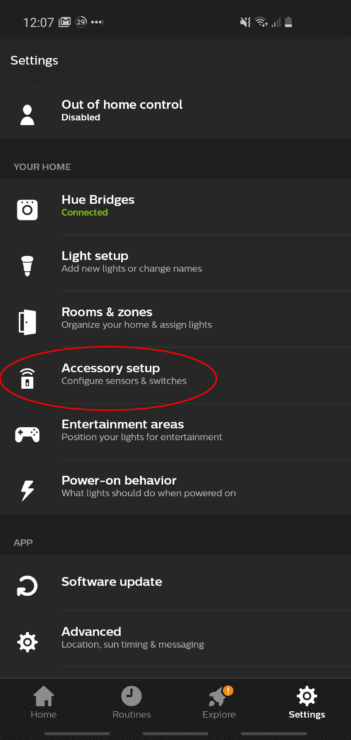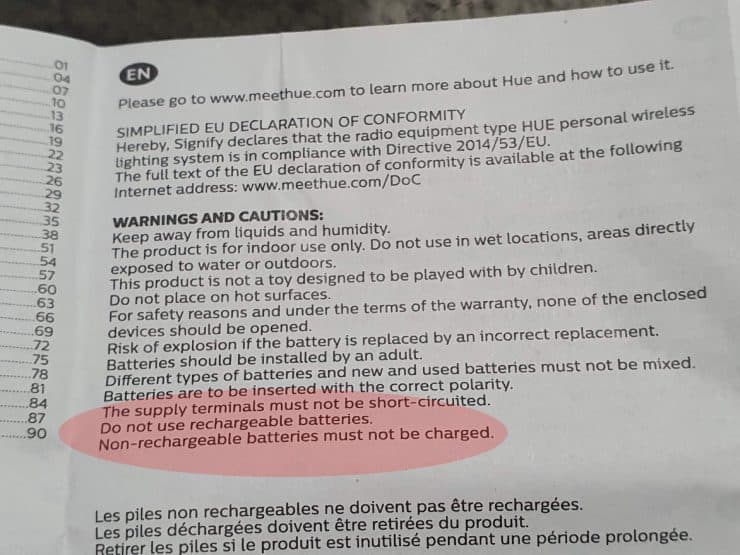The Philips Hue Motion sensor is a really useful tool because it’ll quickly turn on your lights when it detects someone approaching. However if the battery has any issues, your motion sensor may not work as expected. So I wanted to write this guide to talk through everything you need to know about this useful Hue accessory.
The Philips Hue motion sensor takes two batteries (AAA for indoor and AA for outdoor), and it has a “minimal battery lifetime” of 2 years. In practise, it can last for 3 years or more, but there’s more to know about the motion sensor’s batteries.
Philips Hue Motion Sensor Overview

Philips Hue are mainly known for their smart light bulbs and light strips, but they also have a few ‘accessories’ – the motion sensor being a very useful accessory.
This has a passive infrared sensor built into it, and it can therefore detect when someone is walking past it. The sensor can then be configured to turn your Hue lights on/off (or change their color and brightness levels) to suit your liking.
This makes it awesome for welcoming people home (by turning on indoor or outdoor lights), lighting areas of your home that you don’t often go into (especially utility rooms) and a whole lot more.
And luckily it’s not difficult to install: no hardwiring is needed, you can just put some batteries into it. Simple!
In terms of what batteries they work with, the Philips Hue indoor motion sensor accepts two AAA batteries, whereas the Hue outdoor motion sensor accepts two AA batteries.
The bigger outdoor batteries yield more capacity (more on this later), and this is necessary because the PIR sensor is decently bigger on the outdoor model compared to the indoor model (it’s 50% wider and taller, and more than 2x deeper). This enhanced motion sensor capability consumes more energy, meaning that the bigger battery is needed.
How Long The Hue Motion Sensor’s Batteries Last For

A Philips Hue Outdoor Motion Sensor
Despite the different battery sizes, both the Philips Hue indoor and outdoor motion sensors last for “at least” 2 years, with some people finding they last for closer to 3-4 years.
This is because the Hue motion sensors are passive infrared sensors (PIR), which use less electricity than active infrared sensors. Plus they communicate over ZigBee which is known to use less power overall than WiFi based systems.
The only caveat here is that the more that the device triggers, the lower its battery life will be (since it’ll need to send more ZigBee ‘messages’ to trigger your lighting routines). So if they keep getting accidentally triggered by your pets, you’ll probably want to stop this to preserve the battery life.
Finally, as I touched on earlier, the outdoor sensor accepts AA batteries not AAA batteries. AA batteries tend to have 2,000-3,000 mAH capacity compared to AAA batteries (that are usually “up to” 1,000 mAH). This means:
- The Hue indoor motion sensor will run at a max of 1.5V (and 4.5 Wh) across the two AAA cells.
- The Hue outdoor motion sensor will run at a max of 3.0V (and 9.0 Wh) across the two AA cells.
Whilst this looks as though the outdoor sensor will last 3x as long, you have to remember that the actual PIR sensor on the outdoor Hue sensor is much larger than the indoor one (which makes sense because a larger range of motion sensitivity and detection is usually required outside).
But this also uses more electrical power – meaning that despite the bigger battery capacity, the Hue outdoor sensor continues to have around a 2-3 year battery life like its Hue indoor sensor sibling!
How To Know When The Motion Sensor Battery Needs Changing (Tracking the Battery Level Tips)
The Philips Hue app allows you to check and manage all your Hue accessories quite easily:

One of the things you’d expect from this official app is the ability to check the battery level, right?
Unfortunately… that’s not quite the case. The app will warn you when the device has a low battery, but it won’t allow you to see the exact battery level (i.e. whether it’s at 20% or 50% capacity).
What’s frustrating about this is that the battery data is actually provided by the Hue motion sensor, and is available within the Hue API. What this means is that it should be easy for it to be added to the Hue app.
However since it’s not, you can use some third party apps which do display this data. Two that I know of are:
- Hue Lights
- iConnectHue (paid for app)
Hopefully this battery data will be added to the official app soon – I’ll update this page if/when it is!
Can Rechargeable Batteries Be Used In The Hue Motion Sensor?
No, you cannot use rechargeable batteries within either of the Philips Hue motion sensors. When I asked Philips Hue this question, they said: “We do not advise you to use rechargeable batteries”.
Indeed, this is listed in the manual booklet for the sensor too:

This is because rechargeable batteries nearly always run at lower voltages than normal batteries, leading to a less reliable operation overall.
Of course, if you have high voltage rechargeable batteries (which are rare but starting to become more mainstream), there’s no reason why they shouldn’t work well. It’s just that right now, most rechargeable batteries are lower voltage and hence aren’t recommended to be used by Philips Hue.
What Are The ‘Best’ Batteries For Philips Hue’s Motion Sensor?
Any good quality pair of batteries will work fine in Philips Hue’s motion sensors: just make sure to buy AAA for the indoor sensor, and AA for the outdoor sensor.
I’m personally a fan of Duracell, although Amazon Basics have been tested and have quite a good capacity for a much lower price. Either will be fine in the Hue motion sensors:
AAA batteries for the Hue Indoor Motion Sensor
The Indoor Sensor takes triple A batteries (AAA) – I tend to use Duracell but any other brand will work just fine.
AA batteries for the Hue Outdoor Motion Sensor
The Hue Outdoor Sensor accepts double A batteries, which is nice because they hold more charge – meaning they last a little longer. Again, Duracell AA batteries will work fine – although they are a bit more expensive than the competition.
Having said that, any quality battery should give you 2+ years of battery life with your sensors.
How To Replace The Actual Batteries Within The Hue Motion Sensor
The process for changing the batteries on both the indoor and outdoor devices is fairly simple. The indoor Hue motion sensor has a single screw on the back which, when removed, allows you take the back panel off and swap out the AAA batteries. Jump to 3 minutes in the following video to see this:
The outdoor Philips Hue motion sensor is slightly more time consuming – but just because it has four screws to remove, instead of just the one! After removing the four screws, the back panel pops off and again the two AA batteries can be changed:
All in all, it’s a straightforward process and both devices are designed so that it’s not too fiddly to change them.
How To Fix Sync Issues After Changing The Hue Motion Sensor Batteries
In some cases, people have found that their Hue motion sensor isn’t recognized by the Hue app once the batteries have been swapped out. Thankfully this isn’t too common, but it can be quite confusing when it happens because you know the batteries are fine (you even switched tried them in your TV remote to make sure they work, right?!), but it’s just not connecting.
Well there’s a few reasons why this might be happening:
- Your motion sensor may be out of range. If you picked up the sensor and took it somewhere else in your house to change the batteries, it might simply be out of range of your Philips Hue Bridge. This is the same thing as a WiFi WhatsApp call failing when you go outside or to your car quickly.
If this is the case, try moving your Hue motion sensor within a few yards/metres of your Philips Hue Bridge. - Sometimes it just takes time. Some people have reported that their Hue motion sensor won’t be recognized again until sometime the following day! Whilst this is frustrating, it is possible that you just need to wait it out. As long as the batteries definitely are fine and the motion sensor is within range of your Hue bridge, try waiting 24 hours.
- Maybe a reset is required. If it still isn’t being recognized after a battery change, you may need to completely reset it. Firstly remove the accessory from the Philips Hue app.
Then hold down the small setup button (on the back of your Philips Hue sensor) for 10 seconds. It should start blinking red and then orange, meaning it’s in setup mode. At this point, you should be fine to re-add it to the Hue app.
This should fix your issues, but check out my complete guide on this which covers more things to try too.

Thanks for sharing your Hue Motion Sensor battery knowledge. You wrote about this subject with much skill.
Are alkaline batteries preferred? This is implied, but are there not also zinc-carbon ones?
Good question – the included batteries are always alkaline, but the manual itself doesn’t seem to say not to use zinc-carbon (they only say to avoid rechargeable batteries). So it’s a bit unclear at this stage whether zinc-carbon ones are supported, sorry.
I use Energizer Lithium – I started them in other outdoor devices that killed off Duracell and Energizer Alkaline in weeks during the winter months – with temps averaging 9-27F, but occasionally lower.
Anyway – perhaps not an issue everywhere, but worth a mention. I often hear people complaining about outdoor devices in colder climates – and claiming to use the premium battery brands…
The oldest sensor is over 3.5 years now – never changed the batteries. It faces the street and frankly fires too much, but it’s a balance between coverage and sensitivity
Thanks for sharing your experience, that’s pretty impressive performance from Energizer Lithium. I have been a bit disappointed with my Duracell batteries recently, so maybe I should give Energizer Lithium a try.
A little misconception on your battery capacity statements. Putting 2 3000mAh cells together in series does not provide 6000mAh of capacity. It is still 3000mAh, but at twice the voltage (3.0Vdc vs. 1.5Vdc). Amp-hours, alone, is not a measure of how much energy is stored in a battery – the voltage is needed as well to determine that. So a single of your ‘perfect’ AA cells can provide 3000mAh at 1.5V, which means it has 4.5Wh of energy. Two of these cells would be 3000mAh at 3.0V, which means they would have 9.0Wh of energy.
TIL – thanks for the detailed breakdown and correction, that does make sense now that you explain it like that.
I have tried both Philips Hue outdoor motion sensor and Output notion sensor, both not working after changing any oif the sensor’s time setting. The only way to make it work is to RESET the sensor back to the default value. Is it a bug of those sensor or I did something wrong?
Sorry to hear that Ralph. It sounds more like a bug – I have changed the time previously and it worked fine. You can try double checking if there’s any pending software updates for them, but if not, you might just have to continue with your factory-reset approach when this problem re-occurs.